

Writing a Critical Review. The advice in this brochure is a general guide only.
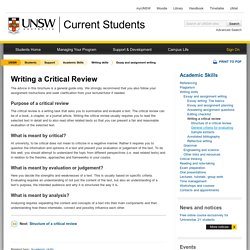
We strongly recommend that you also follow your assignment instructions and seek clarification from your lecturer/tutor if needed. There’s No "I" in Teacher: 8 Rules of Thumb for Collaborative Planning. The Power of Collaborative Learning. Team/Collaborative Teaching. Introduction.
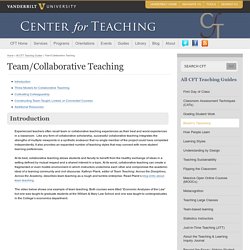
10 Things Every Teacher Should Know How To Do With Google Docs. Google Docs is a powerful word processing tool that many schools have adopted.

As it’s similar to Microsoft Word and other word processing tools, most of its features are intuitive to use. However, in addition to completing many of the functions of a traditional word processor, Google Docs provides even more capabilities that can be invaluable to educators. How Do You Survive the Co-teaching Marriage? Can educators really be expected to survive a “co-teaching marriage” if nearly half of real marriages end in divorce?
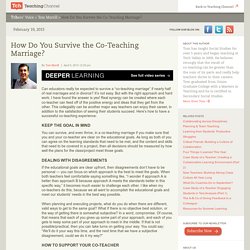
It’s not easy. But with the right approach and hard work, I have found the answer is yes! Real synergy can be created where each co-teacher can feed off of the positive energy and ideas that they get from the other. Teaching in Tandem. Myryame Montrose Elder shares the success of co-teaching content and English The current emphasis in ESL instruction is on a “push-in” rather than “pull-out” method of intervention: ESL teachers collaborate with a content-area teacher and co-teach in the content classroom to ensure ELLs can master vocabulary and concepts.
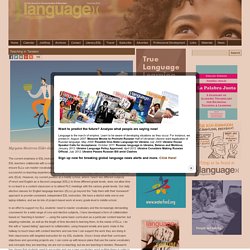
Co-teaching is a great model, and I have had successful co-teaching experiences at the high school level in biology, algebra, and English language arts (ELA). However, my current position at a middle school, where I teach two different subjects (French and English as a Second Language (ESL)) to three different grade levels, does not allow time to co-teach in a content classroom or to attend PLC meetings with the various grade levels. Our daily elective classes for English language learners (ELLs) go beyond the “help them with their homework” approach to provide consistent, independent ESL instruction.
5 More Cool Tools to Take Classroom Collaboration to a New Level. In May, we published the post, 20 Fun Free Tools for Interactive Classroom Collaboration.

Given the high level of interest in this topic, today we offer a guest post with 5 more fun tools for collaborating in (and out of) the classroom! The 2014 Gates Foundation report, Teachers Know Best: What Educators Want from Digital Instructional Tools, informed us that teachers want tools that support student collaboration and provide interactive experiences. Through collaboration, students are able to learn team building, which benefits them for the rest of their lives. Image Source: The Power of Teacher Collaboration. Teaching is simultaneously one of the hardest and one of the most rewarding jobs in the world.

We often say that students make it worth it, but there’s something else that can make or break your happiness as a teacher: your colleagues. In this article, “Research Shows Teacher Collaboration Helps Raise Student Achievement,” researcher Carrie Leana writes about the missing link in school reform: teacher collaboration. In her study of over 1,000 4th and 5th grade teachers in New York City, Leana found that, “students showed higher gains in math achievement when their teachers reported frequent conversations with their peers that centered on math, and when there was a feeling of trust or closeness among teachers.”
Collaboration begins with finding time to connect with colleagues, to share thoughts, and provide support. Here are 3 tips for successful collaboration: 1. Remember to ask your colleagues to share their trials and triumphs with you, too. 2. Top 10 Tips to Use Collaboration Tools in eLearning. In this article, I'll share 10 tips to use collaboration tools in eLearning, so that you can create eLearning courses that are truly interactive, immersive, and innovative.

Each tip, trick, and technique will allow you to not only more effectively utilize collaboration tools, but to make social collaboration an integral part of your eLearning strategy. Collaborative learning is an important part of eLearning. It allows learners to benefit from the experience of their peers, become fully engaged in their own learning experience, and more effectively acquire and retain information. As such, collaboration tools may very well be one of the most powerful tools you have at your disposal as an eLearning professional. Find collaboration tools that are easy to use, accessible, and ideal for your learning goals. 20 Fun Free Tools for Interactive Classroom Collaboration. The 2014 Gates Foundation report, Teachers Know Best: What Educators Want from Digital Instructional Tools, indicates that teachers want tools “supporting student collaboration and providing interactive experiences”.
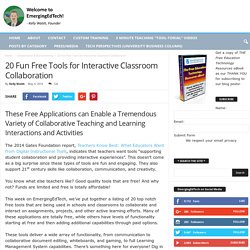
This doesn’t come as a big surprise since these types of tools are fun and engaging. They also support 21st century skills like collaboration, communication, and creativity. How to Reinvent Project Based Learning to Be More Meaningful. By Thom Markham This is a crucial time for education.
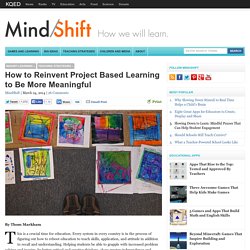
10_Ways_to_Enhance_Communication_and_Collaboration_in_Education_en.pdf. The Advantages of Collaboration in Education. What Is Collaboration in the Workplace? - Definition, Benefits & Examples. Collaboration. Catalan castellers collaborate, working together with a shared goal Collaboration is the process of two or more people or organizations working together to complete a task or achieve a goal.[1] Collaboration is similar to cooperation. Most collaboration requires leadership, although the form of leadership can be social within a decentralized and egalitarian group.[2] Teams that work collaboratively often access greater resources, recognition and rewards when facing competition for finite resources.[3] What Are The Core Principles of Collaboration?
The notion of how we collaborate has been one that whilst often discussed has never really been nailed down. Game theory offers up the basic tit-for-tat principle whereby we collaborate until the other party proves themselves untrustworthy, at which point collaboration breaks down. A new Harvard paper delves into this issue in more detail. Author Nicholas Christakis has form in this area as he’s the author of Connected: The Surprising Power of our Social Networks. His latest research required participants to play a collaboration-testing game over the Internet. The obvious benefit of this approach is that it attracted a much larger sample than is traditionally the case for laboratory research.
Participants in the game were allocated points. The mechanics of the game saw it split into three distinct rule sets. In all versions of the game approximately 60% of players co-operated to begin with. Furthermore, as they were shunned, the defectors began to change their behavior.